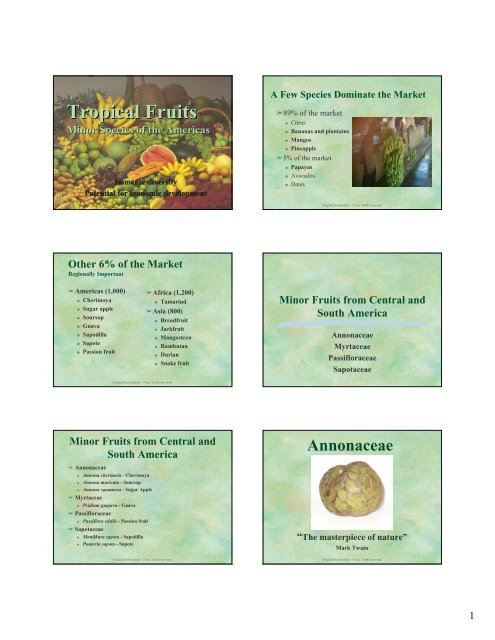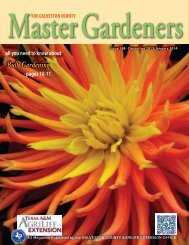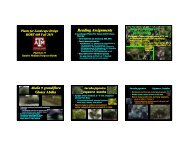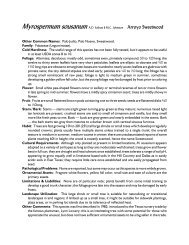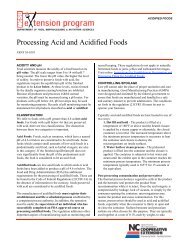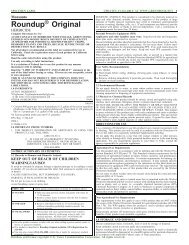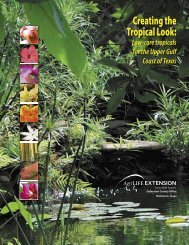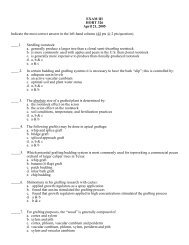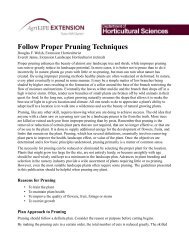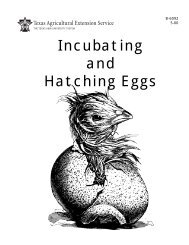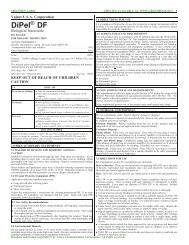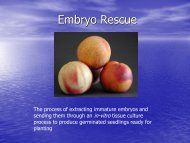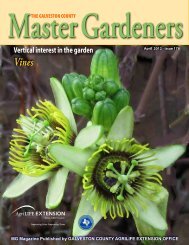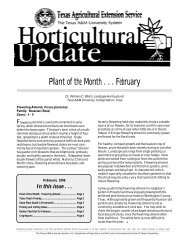Tropical Fruits - Aggie Horticulture - Texas A&M University
Tropical Fruits - Aggie Horticulture - Texas A&M University
Tropical Fruits - Aggie Horticulture - Texas A&M University
Create successful ePaper yourself
Turn your PDF publications into a flip-book with our unique Google optimized e-Paper software.
<strong>Tropical</strong> <strong>Fruits</strong>Minor Species of the AmericasImmense diversityPotential for economic developmentA Few Species Dominate the Market89% of the market Citrus Bananas and plantains Mangos Pineapple 5% of the market Papayas Avocados Dates<strong>Tropical</strong> <strong>Horticulture</strong> - <strong>Texas</strong> A&M <strong>University</strong>Other 6% of the MarketRegionally Important Americas (1,000) Cherimoya Sugar apple Soursop Guava Sapodilla Sapote Passion fruit Africa (1,200) Tamarind Asia (800) Breadfruit Jackfruit Mangosteen Rambutan Durian Snake fruitMinor <strong>Fruits</strong> from Central andSouth AmericaAnnonaceaeMyrtaceaePassifloraceaeSapotaceae<strong>Tropical</strong> <strong>Horticulture</strong> - <strong>Texas</strong> A&M <strong>University</strong>Minor <strong>Fruits</strong> from Central andSouth America Annonaceae Annona cherimola - Cherimoya Annona muricata - Soursop Annona squamosa - Sugar Apple Myrtaceae Psidium guajava -Guava Passifloraceae Passiflora edulis - Passion fruit Sapotaceae Manilkara zapota - Sapodilla Pouteria sapota - SapoteAnnonaceae“The masterpiece of nature”Mark Twain<strong>Tropical</strong> <strong>Horticulture</strong> - <strong>Texas</strong> A&M <strong>University</strong><strong>Tropical</strong> <strong>Horticulture</strong> - <strong>Texas</strong> A&M <strong>University</strong>1
Family AnnonaceaeOver 120 genera and 2,000 speciesMost important genera Annona speciesTemperate species - Asimina triloba• Paw paw, poor man’s banana• Understorey tree• Eastern North AmericaOrigin of AnnonaceaeA. squamosaSugar AppleSE MexicoA. cherimolaCherimoyaAndes in Ecuador and PeruA. muricataSoursopAntilles and northernSouth America<strong>Tropical</strong> <strong>Horticulture</strong> - <strong>Texas</strong> A&M <strong>University</strong>Fruit weighs up to 1 kg3 major species although many others are also eaten<strong>Tropical</strong> <strong>Horticulture</strong> - <strong>Texas</strong> A&M <strong>University</strong>Adaptation of Annona speciesAnnona speciesSpeciesCommonnameAltitude(m)Best growthBest fruitingSpeciesCommonnameTree size Fruit size Adaptationcherimola Cherimoya 700-2400 7-18C min15-28 maxmuricataSoursopGuanábana0-10008-12C min18-22C maxMost tropical of speciescherimola Cherimoya 5-9 m16-30 ftmuricataSoursopGuanábana7.5-9 m25-30 ftMediumLargeSubtropicalCitrus climateLight frosts OK<strong>Tropical</strong>squamosaSugar appleSweetsop0-1000 15-25 min25-32 max17-21C min25-30C maxsquamosaSugar appleSweetsop3-6 m10-20 ftSmall tomediumHot, dry tropicalclimates<strong>Tropical</strong> <strong>Horticulture</strong> - <strong>Texas</strong> A&M <strong>University</strong><strong>Tropical</strong> <strong>Horticulture</strong> - <strong>Texas</strong> A&M <strong>University</strong>Flower StructureStamensFlower to Fruit - Sugar appleThree exterior petalsMultiple stamens and pistilsSanewski. 1991.Custard apples. QDPI.PistilsAlexander, Scholefield and Frodsham. 1987. Some tree fruits for tropical Australia. CSIRO.<strong>Tropical</strong> <strong>Horticulture</strong> - <strong>Texas</strong> A&M <strong>University</strong><strong>Tropical</strong> <strong>Horticulture</strong> - <strong>Texas</strong> A&M <strong>University</strong>2
Aggregate FruitOne flower - multiple pistilsCherimoyaA. cherimolaSanewski. 1991.Custard apples.QDPI. Fruit - Aggregate Medium Normally 150-500 g Up to 2.7 kg 4-8” x 1-4” Shape Conical to heart shaped Smooth to covered withrounded protuberances Skin Thin to thick Flesh Snow white Highly aromatic Many seed<strong>Tropical</strong> <strong>Horticulture</strong> - <strong>Texas</strong> A&M <strong>University</strong><strong>Tropical</strong> <strong>Horticulture</strong> - <strong>Texas</strong> A&M <strong>University</strong>SoursopGuanábanaA. muricataSugar AppleA. squamosa Fruit - Aggregate Large 1 to 6.8 kg 4-12” x 1-6” Shape Ovoid Heart shaped Oblong conical Skin Bitter Flesh ** White, cottony Highly aromatic Brown seed Fruit - Aggregate Small to medium < 0.5 kg 2.3 - 4” long Shape Nearly round, Ovoidor conical Knobby segments Skin Thick Flesh Creamy white Highly aromatic Many seed Carpels adhere loosely<strong>Tropical</strong> <strong>Horticulture</strong> - <strong>Texas</strong> A&M <strong>University</strong><strong>Tropical</strong> <strong>Horticulture</strong> - <strong>Texas</strong> A&M <strong>University</strong>AtemoyaA. cherimola x A. squamosaPropagation - Annona spp Fruit - Aggregate Intermediate betweencherimoya and sugarapple Growthrequirements Intermediate betweencherimoya and sugarappleAfrican PrideGefnerAfrican PridePink’s Mammoth Seed - Traditional Stores dry for 2-4 years Gives variable fruit sizeand quality Grafted onto seedlings Uniform fruit quality Earlier fruiting• 1-2 years earlier Rootstock UsedCherimoya• cherimola or reticulataSoursop• muricata or reticulata• NOT squamosa or cherimolaSugar Apple• reticulata or squamosa<strong>Tropical</strong> <strong>Horticulture</strong> - <strong>Texas</strong> A&M <strong>University</strong><strong>Tropical</strong> <strong>Horticulture</strong> - <strong>Texas</strong> A&M <strong>University</strong>3
Production - PrecocityCherimoya• Bears in 3-5 years• Maximum yields in10th yearSoursop• Bears in 3-4 yearsSugar apple YieldsCherimoya• 25-80 fruit per treeSoursop - shy bearer• 12-24 fruits/tree• 5-16 mt/haSugar apple• 50-100 fruits/tree Pollination Hand pollinationincreases yields Beetles are pollinatorsSoil - Annona species Wide soil range pH 6.5 to 7.6 Sensitive towaterlogging CherimoyaBest• Medium soil• Medium fertility SoursopBest• Deep, rich, welldrained• Semi dry Sugar Apple Water loggingintolerable<strong>Tropical</strong> <strong>Horticulture</strong> - <strong>Texas</strong> A&M <strong>University</strong><strong>Tropical</strong> <strong>Horticulture</strong> - <strong>Texas</strong> A&M <strong>University</strong>Cherimoya As compared to theSugar apple Ships better Better flavor Normally eaten as afresh fruit Commercially grownin many subtropicaland highland tropicalregions No productionfigures availableSoursop Truly tropicaladaptation Uses Some fresh andcanned Pulp is sold Much as drinks Commercially suffersfrom low production<strong>Tropical</strong> <strong>Horticulture</strong> - <strong>Texas</strong> A&M <strong>University</strong><strong>Tropical</strong> <strong>Horticulture</strong> - <strong>Texas</strong> A&M <strong>University</strong>Sugar Apple Not as firm asCherimoya Need to harvestbefore the carpelsseparate Uses Mainly fresh Most widely grown Asia, S. America, S.Mexico, CaribbeanGuavaMyrtaceaePsidiumguajava<strong>Tropical</strong> <strong>Horticulture</strong> - <strong>Texas</strong> A&M <strong>University</strong>4
ProductionGrown widely in Central and south America West Indies India and other parts of Asia AfricaMany places it has naturalizedPlantSmall tree (33’ or 10 m) Spreading structure Bark flakes off<strong>Tropical</strong> <strong>Horticulture</strong> - <strong>Texas</strong> A&M <strong>University</strong><strong>Tropical</strong> <strong>Horticulture</strong> - <strong>Texas</strong> A&M <strong>University</strong>Flowers and FruitThe Guava in the AmericasPollinated by honey beesTwo major commercial types of fruitAmericas - light yellow skin,pink flesh, sweet, acid<strong>Tropical</strong> <strong>Horticulture</strong> - <strong>Texas</strong> A&M <strong>University</strong><strong>Tropical</strong> <strong>Horticulture</strong> - <strong>Texas</strong> A&M <strong>University</strong>The Guava in AsiaOrigin of Guava - <strong>Tropical</strong> America200 BCSpanish and Portuguese explorersspread it to Africa and AsiaFirst evidence ofdomestication in Peru800 BCAsian - green skin, whiteflesh, sweet, low acid<strong>Tropical</strong> <strong>Horticulture</strong> - <strong>Texas</strong> A&M <strong>University</strong><strong>Tropical</strong> <strong>Horticulture</strong> - <strong>Texas</strong> A&M <strong>University</strong>5
Adaptation Soil Widely adaptable pH 4.5 to 9.4 Somewhat salt resistant Good drainage recommended but tolerate poordrainage Climate Thrives in both dry and humid climates Can survive only a light frost Both lowland and in highlands Requires 40 to 80” (1,000 to 2,000 mm) rainPropagationRooting stem cuttings most common<strong>Tropical</strong> <strong>Horticulture</strong> - <strong>Texas</strong> A&M <strong>University</strong><strong>Tropical</strong> <strong>Horticulture</strong> - <strong>Texas</strong> A&M <strong>University</strong>PropagationAir layering and Grafting also donePlanting - higher density in ThailandAmericas 5-10 m squareThailand2-4 m x 5-6 m<strong>Tropical</strong> <strong>Horticulture</strong> - <strong>Texas</strong> A&M <strong>University</strong><strong>Tropical</strong> <strong>Horticulture</strong> - <strong>Texas</strong> A&M <strong>University</strong>Planting - Orchard life shorter in Thailand Americas 30-40 years Productiondecrease after 15years Thailand 4-5 years becauseyield decrease Begin fruiting in 8months fromrooted cuttingInduction of fruitingFruit on new growth from 1 year old woodInduce to fruit by Cut off half of branch Bend to horizontal positionFruit develop inThailand, 16-20 weeksAmericas, 12-21 weeks<strong>Tropical</strong> <strong>Horticulture</strong> - <strong>Texas</strong> A&M <strong>University</strong><strong>Tropical</strong> <strong>Horticulture</strong> - <strong>Texas</strong> A&M <strong>University</strong>6
Induction offruitingFruit thinningThin down to 1-2 fruit per shootEnsure good fruit sizeAvoid breaking branches Bamboo structures inThailand Support Ease of shoot bending<strong>Tropical</strong> <strong>Horticulture</strong> - <strong>Texas</strong> A&M <strong>University</strong><strong>Tropical</strong> <strong>Horticulture</strong> - <strong>Texas</strong> A&M <strong>University</strong>Fruit baggingDone in AsiaFruit baggingDone in AsiaTwo bag sytem• Inside, plastic bag, fruit fly protection• Outside, newspaper, sunburn protection<strong>Tropical</strong> <strong>Horticulture</strong> - <strong>Texas</strong> A&M <strong>University</strong><strong>Tropical</strong> <strong>Horticulture</strong> - <strong>Texas</strong> A&M <strong>University</strong>Fruit yield and harvestHarvested Guava Fruit in Thailand<strong>Tropical</strong> <strong>Horticulture</strong> - <strong>Texas</strong> A&M <strong>University</strong> Thailand 90% fresh Americas Commonlycooked/processed• Canned• Paste• Jelly• JuicePassion fruitPassifloraceaePassifloraedulis7
PlantPerennial climberUp to 15 m (50 ‘)Passion flowerPassifloraceaePassifloravarious species<strong>Tropical</strong> <strong>Horticulture</strong> - <strong>Texas</strong> A&M <strong>University</strong>Flower andfruitOrigin of Passiflora edulis Flowers Solitary, showy, incompatible Current season growth Flowers throughout year Fruit Berry Mature in 8-12 weeks<strong>Tropical</strong> <strong>Horticulture</strong> - <strong>Texas</strong> A&M <strong>University</strong>Purple passionfruitoriginates from southernBrazil, northernArgentina, and ParaguayThe origin of the yellowpassionfruit is notknown<strong>Tropical</strong> <strong>Horticulture</strong> - <strong>Texas</strong> A&M <strong>University</strong>Adaptation Subtropical to <strong>Tropical</strong> Highland Climate Needs highland climate for good flowering and fruiting• Cool winters (5 C; 41 F), no frosts• Warm summers (14 to 24 C; 57 to 75 F) Yellow passionfruit is more tropicalRain• 760-1,200 mm per year• Poor set if rain during flowering Poor tolerance to wind - requires trellis Soil Medium texture pH 6.5 - 7.5Well drained<strong>Tropical</strong> <strong>Horticulture</strong> - <strong>Texas</strong> A&M <strong>University</strong>Production Americas Brazil, greatestproducer of juice Colombia, Ecuador,Peru Africa South Africa Kenya Asia New Guinea Taiwan India Sri Lanka Australia Hawaii<strong>Tropical</strong> <strong>Horticulture</strong> - <strong>Texas</strong> A&M <strong>University</strong>8
PropagationSeed propagation Usually done by seed Seedlings can be used for rootstockVegetative propagation Layers or rooted cuttingsGrafting• Maintain hybrids• Use rootstock resistant to nematodes and diseaseSpacing 3-6 m between plants 2-5 m between trellisrowsTraining and Pruning Two wire fence trellis Train leaders to wires Periodically tip backlateralsPlanting<strong>Tropical</strong> <strong>Horticulture</strong> - <strong>Texas</strong> A&M <strong>University</strong><strong>Tropical</strong> <strong>Horticulture</strong> - <strong>Texas</strong> A&M <strong>University</strong>Cultivation and fruitingFruiting Begins in 15-18 months Productive life 4-8 years Yield, 3-30 MT/haNeeds cross pollination for goodproduction Pollinators: bumble bees and hummingbirdsHarvestingHarvest Picked from ground daily(ripe fruit fall) Picked from vines 1-3times/weekExpensive to harvestFruit productsMainly juice (30-40% yield)<strong>Tropical</strong> <strong>Horticulture</strong> - <strong>Texas</strong> A&M <strong>University</strong><strong>Tropical</strong> <strong>Horticulture</strong> - <strong>Texas</strong> A&M <strong>University</strong>SapodillaSapotaceaeManilkarazapotaPlantSlow growing, long lived tree Elegant pyramidal shape 60 - 100’ (18 - 30 m)Strong, wind resistantBark Rich in chicle - a white, gummy latex Base for chewing gum<strong>Tropical</strong> <strong>Horticulture</strong> - <strong>Texas</strong> A&M <strong>University</strong>9
Flowers and Fruit Flowers Small and bell like 3 sepals/petalsFlowers and Fruit Fruit Round to conical 2-4” (5-10 cm) wide Skin - rusty brown, scurfy Immature Hard, gummy Very astringent (tannins) Flesh Yellowish to reddishbrown Grainy to smooth Sweet flavor like a pear 0-12 seed<strong>Tropical</strong> <strong>Horticulture</strong> - <strong>Texas</strong> A&M <strong>University</strong><strong>Tropical</strong> <strong>Horticulture</strong> - <strong>Texas</strong> A&M <strong>University</strong>Taken toPhilippinesearly inColonial periodOrigin of SapodillaOriginated in Yucatanand surrounding areasCultivated in CentralAmerica since ancienttimesProductionWild trees in Mexico (Tabasco, Chiapas,Yucatan) Tapped for chicle gumTree cultivated for fruit throughout thetropics<strong>Tropical</strong> <strong>Horticulture</strong> - <strong>Texas</strong> A&M <strong>University</strong><strong>Tropical</strong> <strong>Horticulture</strong> - <strong>Texas</strong> A&M <strong>University</strong>AdaptationNot strictly tropical Mature tree can withstand 26 F (-3C) forseveral hours Young tree can be killed by 30F (-1C)SoilAdapted to calcareous soilsGood drainage neededDrought resistantSalt resistantPropagationSeed Germinate readily Fruit in 5-8 yearsVegetative propagationGraftingAir layers (fruit in 2 years)<strong>Tropical</strong> <strong>Horticulture</strong> - <strong>Texas</strong> A&M <strong>University</strong><strong>Tropical</strong> <strong>Horticulture</strong> - <strong>Texas</strong> A&M <strong>University</strong>10
PlantingSpacing 35-40 feet (Morton) 15-20 feet in India (Storey) 30 feet in poor soilCultivation and fruiting<strong>Fruits</strong> mature 4-6 months after floweringFruiting season In tropics, almost continouslyMexico• Peak harvest is Feb-April and Oct-DecFlorida• Harvest from May to Sept• Peak in June and July<strong>Tropical</strong> <strong>Horticulture</strong> - <strong>Texas</strong> A&M <strong>University</strong><strong>Tropical</strong> <strong>Horticulture</strong> - <strong>Texas</strong> A&M <strong>University</strong>Harvesting - Major by productChicle Was chewed by the Mayans Tapped from wild and cultivated treesIntroduced into the USA in 1866 Commercialized by incorporating flavors Peak production in 1930 Now replaced or diluted with other latexesor synthetic gumsSapoteSapotaceaePouteriasapota<strong>Tropical</strong> <strong>Horticulture</strong> - <strong>Texas</strong> A&M <strong>University</strong>PlantTree 60-100’ (18-30m) Variable tree shape Deciduous orevergreen<strong>Tropical</strong> <strong>Horticulture</strong> - <strong>Texas</strong> A&M <strong>University</strong>Flowers and FruitFlowersSmall flower clusters (6-12) formin axils where leaves have fallenFruit Round to elliptical• 3-9” (7.5-23 cm)• 0.5-5 lbs (0.2-2.3 kg) Rind, brown, leatheryFlesh• Salmon pink to red• Soft• Sweet, pumpkin-like flavor<strong>Tropical</strong> <strong>Horticulture</strong> - <strong>Texas</strong> A&M <strong>University</strong>11
Lowlands of southernMexico and northernNicaraguaOrigin of SapoteAdaptation<strong>Tropical</strong> to near tropical climates Elevation up to 2,000’ (610 m) Cold sensitive - defoliation and death Rain• 70” (1,780 mm)• Intolerant of droughtSoilsBest growth - Deep clay and clay loamTolerates a wide range of soilsSensitive to waterlogging<strong>Tropical</strong> <strong>Horticulture</strong> - <strong>Texas</strong> A&M <strong>University</strong><strong>Tropical</strong> <strong>Horticulture</strong> - <strong>Texas</strong> A&M <strong>University</strong>ProductionMainly cultivated in Central Americaand tropical South AmericaPropagationSeed propagationSeed lose viability quicklyOnly for rootstock Seedlings are variable and slow to bear (8-10years)Vegetative propagationBudding and graftingBear in 1-4 years<strong>Tropical</strong> <strong>Horticulture</strong> - <strong>Texas</strong> A&M <strong>University</strong><strong>Tropical</strong> <strong>Horticulture</strong> - <strong>Texas</strong> A&M <strong>University</strong>Cultivation and fruitingSpacing 25 to 40’ (7.5-12 m)Time to bear fruitGrafted trees bear in 1-4 yearsFruit well for 100 yearsHarvesting Maturity determination Difficult Reddish tinge Sample fruit on tree andcheck flesh color Harvest By hand Picking pole with cutter<strong>Tropical</strong> <strong>Horticulture</strong> - <strong>Texas</strong> A&M <strong>University</strong><strong>Tropical</strong> <strong>Horticulture</strong> - <strong>Texas</strong> A&M <strong>University</strong>12
Any Questions?<strong>Tropical</strong> <strong>Horticulture</strong> - <strong>Texas</strong> A&M <strong>University</strong>13


